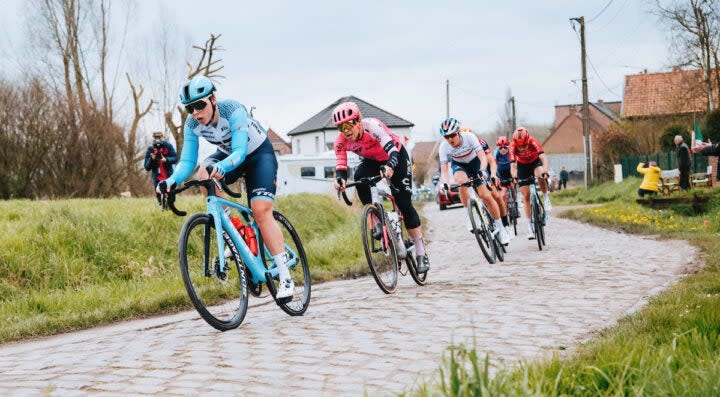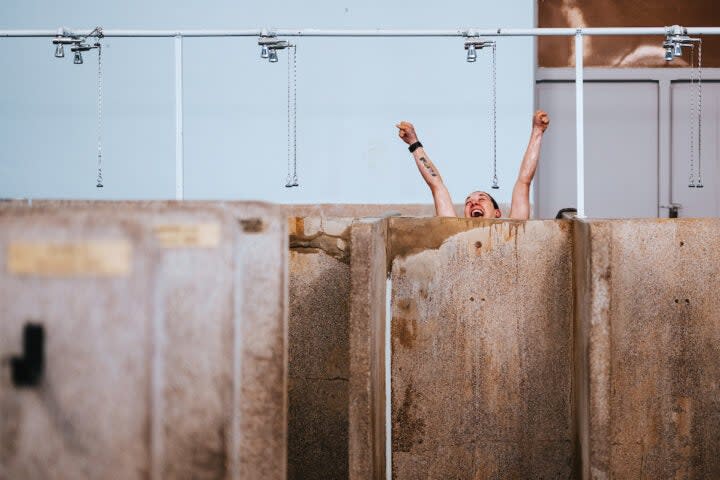Paris-Roubaix Femmes: How the breakaway foiled the favorites
This article originally appeared on Velo News
Three editions in and Paris-Roubaix Femmes avec Zwift has got its first true early breakaway win.
Saturday's race, which was won by Alison Jackson (EF Education-TIBCO-SVB), really saw the underdogs get one over on the big favorites with the remnants of a substantial breakaway holding off a big chase to contest the victory. It was like Mat Hayman in 2016 all over again.
Yes, Lizzie Deignan's victory in the opening edition was a long solo attack that began on the opening cobbled sector. As epic as it was to watch, it wasn't a "breakaway win" in the traditional sense.
Since it was finally added to the women's calendar in 2021, Paris-Roubaix Femmes has been developing as a race. The route has been tweaked each year, adding a little bit more to the pre-cobbles section of the course.
When Deignan romped to victory, the bunch was essentially all together heading into the first sector as 31km of racing was just not enough to form a proper breakaway. Deignan got a small advantage over the front of the bunch when it hit the cobbles and was able to hold the chasers off with a huge ride.
Also read:
Lotte Kopecky's quest for prestigious Tour of Flanders - Paris-Roubaix double derailed by crash
Trek-Segafredo's grip on Paris-Roubaix Femmes ends, but team goes down swinging
An extra loop was added for the following year to give an extra nine kilometers of action before the cobbles arrived. A small breakaway did form, but it quickly fell apart when the cobbles arrived and the move was done just halfway into the race.
This year saw a massive 63 kilometers before the first pave sector from Hornaing to Wandignies loomed into sight. In the first edition, the riders were already trundling toward Mons-en-Pevele and last year that distance would have seen them approaching the fifth pave sector of the day.
Pushing the cobbles further out allowed the race allowed the racing to develop and establish itself before the destructive nature of the pave started taking its toll. It took well over 20 kilometers for the breakaway to fully establish itself this weekend with the group building up from several smaller attacks.
Eventual winner Alison Jackson explained the dynamics best in her winner's press conference Saturday.
"The first edition was far too short. We did two crit laps and then we were straight into the cobbles. This now we had time to set up the race. We set up the race with this break going early and it was a big break, and not many teams missed it, and then also Paris-Roubaix always getting ahead of the tough positioning in the cobbles was always going to be better and when you're in a smaller group there's always less fighting," she said.
"It had rained earlier this week, so some of the cobbles were going to be wet and the cobbles were going to be muddy. Just to get ahead, you're saving yourself from bad luck, crashes, flats. The group wasn't always working together but there were enough girls that you see this as your chance. In Paris-Roubaix, to go in a group that early, if you watch the men's, those can go really far. I just wanted to get ahead of Lotte Kopecky, basically. It's always a gamble."
Making the most of the moment

By the time the leading group of 18 hit the first sector of cobbles, it had a substantial lead of over five minutes. Of course, as the men's race has shown, a big lead for the breakaway doesn't always translate into a win for those that go on the attack early.
Anything can happen on the cobbles and when the big favorites light it up behind gaps can come down very quickly. However, there were already some advantages in the favor of the leaders at this point already.
With nearly every one of the major teams represented in the move, there were questions over who might take responsibility for the chase. Would any team be willing to try and chase down its own rider on the off chance it might ruin a good chance at winning?
That confusion helped the breakaway to really establish itself. While there was some looking at each other in the breakaway, too, there were enough riders determined to make it work that kept pulling it along -- even when Team DSM's Daniek Hengeveld decided to go on a solo attack.
"In the beginning, some teams were not riding. I understand because SD Worx and some other teams had their best riders behind," third-place finisher Mathe Truyen said after the race, before adding her thoughts on the finale of the race.
Eventually, it was Trek-Segafredo that decided to pull the trigger on the chase. While the team had Lisa Klein in the breakaway move, it wasn't confident that she would be able to hang on after she had fallen ill earlier in the week.
With Elisa Balsamo now on the front, the gap was coming down and the fate of the breakaway was in the balance. Trek's injection of pace lit a fire under some other teams, too, and SD Worx also began to put the hammer down.

The break was given some respite when nearly the whole group of favorites was felled on sector 9 from Pont-Thibault to Ennevelin when the defending champion Elisa Longo Borghini came down at the front of the group. Some riders remounted quickly while others took longer, and it slowed the chase for a few kilometers.
It wasn't a make-or-break situation, and Thuyen admitted afterward that she wasn't aware of the fall, but it certainly turned the balance toward the breakaway group. The pace was quickly reducing the number up front and soon there were just seven remaining. However, there was depth in the group and the experienced Jackson worked to rally the troops.
"If our group wasn't going to work, we were going to lose the race. I've been in the sport longer than a lot of the girls that were in the break, and it was so important that I was still rolling through and I would keep committing to the break. I think it shows other riders that they can do the same. There were also lots of up-and-coming riders that were in that move," Jackson said.
There were over 30 kilometers to go at this point and everything was still to play for. It wasn't all peace and love in the breakaway and several riders, including Jackson, but in some big moves off the front to try and break up the group.
The gap to the chasers continued to come down as did the kilometers and heading into the penultimate sector of cobbles the leaders were just 10 seconds ahead. With the finish line approaching, the break seemed galvanized as it approached the velodrome, while the chase behind broke down.
In the end, that switch in dynamic proved to be the ultimate difference between the breakaway and the chasers.
"In the end, I didn't understand why some of [the break] wouldn't ride because if we stay in front then we are all top seven, which is really nice at a monument. But some riders didn't like to get a top seven, I think. I was a bit disappointed in them, but they started riding again at the right moment," Truyen said.
There was no one big thing that happened that allowed the final seven escapees to make it to the velodrome ahead of the major favorites, instead, it was several smaller factors that played into their hands.
For exclusive access to all of our fitness, gear, adventure, and travel stories, plus discounts on trips, events, and gear, sign up for Outside+ today.

